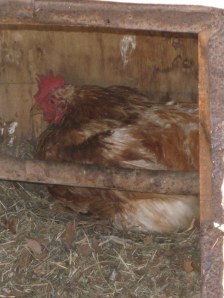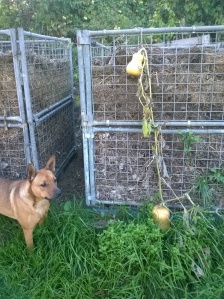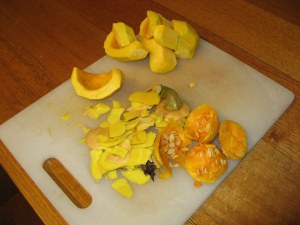
Amateur and professional beekeepers working side-by-side
A couple years ago, my husband and I became backyard beekeepers. Frank’s father had been a hobby/semi-professional beekeeper yonks ago so Frank had some idea what he was getting into, though that was a different hemisphere and a different generation. I really didn’t know anything about beekeeping before we started but I’m the sort that likes jumping into the deep end.
The way we learned was to join a local amateur beekeeping club, read every book on beekeeping the local library stocked (literally) and I spent hours online perusing websites and blogs. Most of this happened after we brought the bees home but we did get a critical introduction from the local club’s apiarist on one of their open days.
Absolutely every one I talked to, every thing I read and every reference I uncovered was aimed at backyard beekeeping (I assume professional beekeepers are too busy to blog!). Generally people with 1-6 hives, almost always people who weren’t overly fussed if they harvested any honey at all, typically people with jobs and lives well away from horticulture/agriculture/farming/animal husbandry.
Then I landed this caretaker gig at the farm owned by the Wheen Bee Foundation and was introduced to professional apiarists. These guys have made a career out of bees in the government or commercially. They keep hives which number in the hundreds (or thousands) and are active in the professional bee community. I was keen (continue to be keen) to learn from these experts. I’ve still got a long row to hoe, but I have found some differences that I figured I’d share.
The differences really fall into 2 categories: attitude and method. I’ll discuss them separately below.
The attitude of a professional beekeeper is much more zen about the life of a bee, even a colony of them. A bit of disease, a few squished bees, a pile of dead bees – well that’s just to be expected and something good colonies can overcome. The seasoned profi takes it in his stride and makes a snap decision about whether intervention is necessary for the good of the apiary or whether to leave the hive to its own devices. If hives die, as long as there’s not disease risking the apiary, they can be replaced with splits in spring. Thankfully I haven’t met anyone as ruthless as the guy in the film More than Honey who sees bees strictly as a dollar figure, but the professionals I’ve me also don’t get too emotional about insects.
A backyard beekeeper tends to fret about little things, strives to keep every single bee happy and healthy and worries about the comfort of their bees (Is it too hot today? Maybe I should move a water source a little closer. Will they stay nice and toasty if I put a bit of linoleum on top of the hive?) The end result is a lot of questions, bees being inspected too often, more time spent in contemplation with the hive open (and therefore vulnerable) and more stress for the beekeeper and quite possibly the bees as well.
I don’t know that I’ll ever get as casual about my hives as a professional, but I’m trying to get better at not worrying quite so much about things that aren’t perfect in a colony.
Then there’s the method employed by a professional beekeeper. I guess it can be summed up in a single word: efficiency. The old-hands I’ve worked with here are into a hive, slinging boxes, lifting frames, shaking bees and then onto the next hive before I have my camera out of its case. A full inspection of 23 hives including checking the brood frames, installing queen excluders, fitting and/or cleaning beetle traps, and moving frames and boxes between hives to help out a few weaker hives takes about 2 hours. I think Frank and I could accomplish the same feat in about 2 days on our own. Some of that speed comes from practice and experience which also breeds confidence, but a lot of it comes from attitude (see above) as well.

Into the brood, supers on lid, right side up

Lid still on super, tipped on its side
As amateur beekeepers, we are very methodical, opening first the lid which we turn upside down next to the hive to hold the top super. The second super is moved onto the top super and so on until we get down as far into the hive as we want to go. We do this no matter why we’re entering a hive.
The profi’s I’ve met tend to set the supers, full of honey-laden frames, on their side. I was taught that you shouldn’t change the orientation of the boxes – bees don’t like it and nectar could drip and drown bees. I’ve raised this concern with two experts and they just grin. They do it this way because it’s faster (good for bees and beekeeper) and easier on their back (which can be critical if you’re lifting hundreds of boxes in a day). It also apparently helps when honey-harvesting, the bees escape quickly from boxes standing on their side and, those that don’t, can be blown out (using a normal leaf blower).

Hanging oil traps
There is one problem with this upending of boxes now that we have small hive beetles in Sydney. If you use the hanging oil trap that fits between frames, it will spill and kill a lot of bees which may be why I haven’t met a professional beekeeper who uses this kind of trap.
The most obvious difference in the way an amateur behaves around a bee hive compared to the way someone who makes his living off of bees behaves is that the profi is more targeted whenever opening a hive. He only goes into hives when he needs to and then doesn’t delay things by looking around out of curiosity. As near as I can tell there are for 4 reasons a profi will open a hive: to harvest honey, to check the health of a hive, to manipulate hives (split, merge or redistribute frames to strengthen weak hives) or to requeen. Harvesting honey is easy – off come the supers (judged to be ready for harvest more by heft of the hive than by frame inspection) and the brood is left alone.

Queen spotted on the brood
For the other activities, it’s all about the brood. In these cases he pops the top super off with the lid still attached, sets it on its side and goes into the next box. If there are 2 supers he can tip them both over together (I’ve been told by one he does this though never seen it in action – the supers are too heavy and he says you need a log or something to tip the hive over). Since he’s only interested in the brood (where you’ll find any disease or health issues and, obviously, the queen) and how the bees behave around the brood he doesn’t worry about the honey supers. Nor does he try to see the queen (unless it’s time for requeening) he just needs to find evidence of her laying.

Brood inspection
The profi can even judge which box holds the brood by weight. Normally it’s the bottom box (if you use queen excluders, this is pretty much guaranteed) but, if you don’t have an excluder in place, the queen can move up a box or 2, especially if it’s winter and she’s seeking warmth. Once he’s in the brood nest, he starts pulling out frames. In a nano-second he identifies if the brood is healthy, then he either sets the frame aside to go into another box (when moving or consolidating the brood) or slips it back into the box where he wants it. Frames being moved out of the brood box get a good shake to make sure the queen didn’t get shifted where she wasn’t wanted. I once saw a beekeeper pick the queen off a frame and drop her in the top of the brood box faster than I could even spot her. Something I’d never try for fear of damaging that most valuable of bees.
I have to admit that the professionals seem rougher with the bees than I’ve been taught as a backyard beekeeper but, because they’re so much faster, I think the bees are probably less traumatised and have less time to get angry. Profis may even squash less in their quick, decisive moves than we manage with our careful sliding and jiggling of things into place (though I’m not convinced on this point).
Maybe there’s a third category of difference beyond attitude and method – it’s just plain old knowledge. Watching a professional beekeeper “inspect” an apiary is a thing of wonder. He walks in and can determine by sound and movement where he needs to look further. A moment spent squatting in front of a worrying hive before bending over behind the hive to lift the back to see how heavy it is enough to tell a profi what the problem most likely is. It’s almost a 6th sense.
I can’t close this post without pointing out a the most amusing difference between the way the profis I’ve met on this farm (maybe not all professional beekeepers) and I (maybe not all backyard beekeepers) work: protective gear. I suit up with hood, gloves, boots, overalls and prayers. They go out with no gloves, sometimes short sleeves and shorts, and generally no head gear at all (though they are maniacs with the smoker). In the photos above, one of the beekeepers did put on a hat with a net over it though on the 2nd hive the net came up and protected his hat, but not his face. I can confirm every profi I’ve worked with gets stung, but it just doesn’t bother them. Or at least, not as much as the gear would. I’ve met beekeepers that actually say they find short sleeves more comfortable. More comfortable even with many stingers in your arms!?!
Basically, amateurs talk a lot about bee stings and don’t like them, professionals just shrug it off and get on with things.
Here’s me in my quick-inspection suit. I skip the full jumpsuit if we aren’t going to be spending a lot of time in the hives. And I feel brave with this “minimal” beekeeper’s outfit!

I’ve got a long way to go before I could be mistaken for a professional beekeeper, and if it requires me to be sleeveless during hive inspections, that’s one masquerade I’ll never pull off.
 I’m a member of the Nepean Amateur Beekeeper’s Association and we meet every month to talk about bees and check out the club hives. Since it’s winter, we aren’t opening the hives and so it’s a good time to think about what’s going on with bees outside of our little universe. This month, Shona Blair, the CEO of the Wheen Bee Foundation, the mob that owns the farm where I live and work as caretaker, came out to the farm and gave us a great presentation. The club got information and a field trip all rolled into one.
I’m a member of the Nepean Amateur Beekeeper’s Association and we meet every month to talk about bees and check out the club hives. Since it’s winter, we aren’t opening the hives and so it’s a good time to think about what’s going on with bees outside of our little universe. This month, Shona Blair, the CEO of the Wheen Bee Foundation, the mob that owns the farm where I live and work as caretaker, came out to the farm and gave us a great presentation. The club got information and a field trip all rolled into one. Honey works to heal wounds and burns on several fronts including (but not limited to): starving the bacteria of water, providing hydrogen peroxide as an antibacterial agent and actually assisting regeneration of tissue (something no lab produced medicine can do). A lot of research is being done to investigate which types of honey work best and how this treatment can be applied in modern hospital situations.
Honey works to heal wounds and burns on several fronts including (but not limited to): starving the bacteria of water, providing hydrogen peroxide as an antibacterial agent and actually assisting regeneration of tissue (something no lab produced medicine can do). A lot of research is being done to investigate which types of honey work best and how this treatment can be applied in modern hospital situations. We all know (at least those of us who are bee crazy do) that, globally, 1 out of every 3 mouthfuls of food comes from a bee pollinated plant, but Shona gave some examples that aren’t commonly considered like onions and carrots. Sure, we don’t need bees to produce the vegetable but, if we want seeds so we can have food next year too, we need bees to pollinate the flowers.
We all know (at least those of us who are bee crazy do) that, globally, 1 out of every 3 mouthfuls of food comes from a bee pollinated plant, but Shona gave some examples that aren’t commonly considered like onions and carrots. Sure, we don’t need bees to produce the vegetable but, if we want seeds so we can have food next year too, we need bees to pollinate the flowers.













































